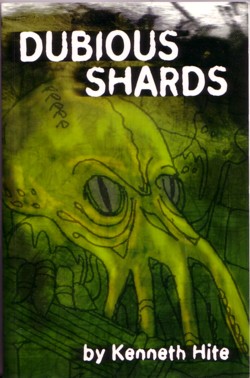Dubious Shards
by Kenneth Hite
Originally for the Samhain, 2006 mailing of the Esoteric Order of Dagon (#136)

Ken Hite is one of the most erudite and interesting people working in the role-playing game industry today. To some, that may be damning him with faint praise, but he really is quite the writer. His column, "Suppressed Transmissions", which appears less and less frequently these days, used to be a staple of conspiracy theory and Tim Powers-style interconnectedness of unusual events. Additionally, Ken has long been a proponent of Call of Cthulhu, Chaosium's little horror game which has garnered more Origins awards than any two other games combined. And thus we come to a little book, almost a pamphlet, which was available at Origins this year: Ken Hite's Dubious Shards.
This small, 105-page booklet is comprised of seven essays and one long RPG scenario, interspersed with these are Ken's illustrations of his vision of the major arcana in a Tarot of Cthulhu. Ken has made a name for himself with his "Suppressed Transmissions" column, in which he takes a look at life and history with his paranoid, what-if-all-this-is-linked hat on. Considering that he is well-read in history, Ken makes for some very links between very disparate historical events. Before reading his "The Shadow over Lovecraft", for example, I had never heard of the Benandanti, a secret group of Italian mystics who battled witchcraft and devilry in their dreams, only to be scattered by the Inquisition in the 16th century.
Hite presents several articles in the Lore section of his book, including "The How of Hastur: Ruminations on Applied Yog-Sothothery", possibly the most useful section of the book. In it, the author peels away the outer trimmings of Lovecraft and gets to the heart of what Lovecraft wrote, with extensive reference to Lovecraft's letters. He does so with the purpose of showing the aspiring Call of Cthulhu game master how to use Lovecraft's tools and techniques in service of creating a similar atmosphere in a game, but the advice also applies to anyone attempting fiction.
Most of the other articles are shorter and more esoteric, not offering the practical advice of "The How of Hastur" rather connecting Lovecraft's creations with real-world events and locations. "The Trail of Dagon" follows Dagon from Philistine deity to Biblical opponent of Samson to Plymouth Plantation. "Irem, City of Pillars" discusses the city and its reputation, citing links that range from Qur'an to Richard Burton to Kim Philby. "Vampish Vapors in the Shunned House" explored New England's rich vampire lore, and "Down to Dunwich" is more about the sinking town of the Suffolk coast than Lovecraft's fictional New England town. "The Shadow out of Lovecraft" examines the possibilities offered from Loveceraft's own life, comparing him to the previously-mentioned Benandanti. Did Lovecraft battle demons and horrors from beyond in his dreams? Probably not, but it could make for an interesting story.
"The Shadow from the Right" is a very detailed review and analysis of Michel Houellebeq's Against the World, Against Life, much better than my own review, as it holds Houellebeq's unspoken but very present assumptions about politics and horror up to the light and examines them thoroughly.
The final piece, "The Man Who Shot Joseph Curwen" places Lovecraft and his works firmly within the spectrum of American literature, and, borrowing from Don Burleson's
"Lovecraft: An American Allegory", and paralleling the essential conflict of Lovecraft's stories with those of the quintessentially American genre, the Western. In the same morality of the Western, in that barbarism can only be defeated with a gun, yet anyone who picks up a gun is a barbarian, so too with Lovecraft–Horrors Beyond can only be dealt with by people who understand them, and to understand the Horrors Beyond is to distance yourself from humanity. Only Ken says it better.
What's rather unfortunate is that the physical book was issued in very small numbers from Ronin Arts. These are now extremely hard to come by–instead, those of us who want a copy must console ourselves with PDF copies, available from such places as rpgnow or yog-sothoth dot com, but something like this really deserves to be read off paper, not a screen.